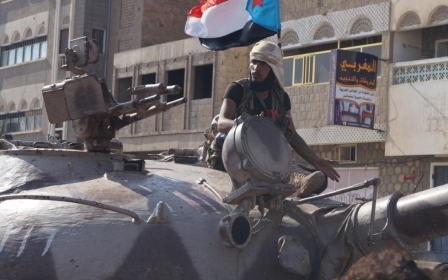Sectarian strife is fuelling Middle East's arms trade

It may have caught the West off guard but the lightning airstrikes launched by Saudi Arabia and its allies against the Iranian-backed Houthi insurgency in Yemen has been a long time coming. The Saudis were well armed and well prepared. Very well armed indeed.
The strikes came barely a week after defence specialist IHS Jane’s released a study that showed Saudi Arabia had become the globe’s largest importer of weapons and defence systems in 2014.
Now, suddenly one of the most heavily weaponised regions in the world finds itself teetering on the edge of a major war.
Up until last Thursday’s attack, the Gulf Cooperation Council (GCC) states had kept its powder dry while the Iranian-backed Houthis drove the Saudi-supported President Abd Rabbuh Mansour Hadi out of the capital Sanaa. He fled to the southern port city of Aden and it was the Houthis rapid drive into the south - which ultimately saw Hadi flee the country - that finally forced the Saudis’ hand.
Now, with reports that they are massing a ground force of 150,000 on their southern border with Yemen and the Iranian foreign minister speaking of a “very dangerous situation,” what had been something of a proxy war threatens to explode into a wider regional conflict.
Should that happen there are plenty of weapons to go around.
Last year alone, the Saudis spent $6.4bn on high-tech weaponry. Key allies the UAE snapped up another $2.2bn worth of armaments. The list of purchases in the past five years is impressive: F15 fighter jets, Apache combat helicopters, Piranha armoured personnel carriers (APCs), IRIS-T air-to-air infrared missiles, Caesar 155mm self-propelled howitzers, unmanned aerial vehicles (UAVs), air-borne early warning aircraft (AEWs), ballistic missile defences, corvettes, landing craft, anti-tank missiles. The list goes on and on. Everything you need and then some to carry out a very modern war.
Not to be outdone, the Iranians are engaged in talks with Russia about purchasing the latest they have to offer in anti-aircraft missile defence systems. And the Russians - who had been argued out of a similar sanctions-busting sale in 2010 - now look ready, nay eager, to do the deal, particularly as their economy is feeling the effects of the West’s sanctions, imposed because of Russian actions in Ukraine.
Sergei Chemezov, the head of the state-owned armaments giant Rostec, was quoted in Russian News Agency Tass last week - before the strikes were launched - as saying “we offered (the missiles) and they are thinking. No decision has been made yet.”
Chemezov went on to say: “I don’t conceal this, and everyone understands this, the more conflicts there are, the more they buy weapons off us. Volumes are continuing to grow despite sanctions.”
It will not have been lost on the Iranians that the Yemen airstrikes targeted missile sites around the capital Sanaa, and in the south, the al-Anad airbase and military installations in the city of Taiz. They will be analysing the effectiveness of the strikes and what they find out may help them make up their minds about the deal the Russians have offered. But even if the deal does go through, it will leave them lagging far behind in the regional arms race.
Michael Stephens, the head of RUSI Qatar, has argued that the Gulf States have a distinct edge over the Iranians when it comes to weaponry. “They have the volume, the quality, the technical and maintenance capability that Iran just doesn’t have,” he said.
But Iran has shown itself to be exceptionally skilled at what Stephens calls “deployable capacity overseas”. That is the ability to carry out sustained asymmetrical warfare in someone else’s backyard.
But after two years of successes shoring up the Assad regime through its surrogate Hezbollah and being largely responsible for beating ISIS back from the outskirts of Baghdad, Shiite Iran will be uneasy seeing Sunni Saudi Arabia flex its military might in a way it has never come close to doing before.
Alex Vatanka is a senior fellow at the Jamestown Foundation in Washington DC. Commenting on the growing sectarian strife, he told me: “Iran is guilty of sectarianism but there is another side to the equation and that is the Saudis and increasingly the Emiratis and the Qataris. This is not something that the West can take a lead in. It has to come from the Islamic world and I don’t see anyone emerging. On (confronting) sectarianism, there is a lot of rhetoric but no leadership.”
That vacuum has seen both sides reaching for their weapons in the proxy wars that have raged in Syria, Iraq and now Yemen.
Vatanka adds that a comment he often hears from the Middle East is that it is the West that is fuelling sectarianism as a way of selling arms. It is, he hastened to add “not a conspiracy theory I buy into. The sectarianism comes from within.”
But as the sectarian conflict expands, the Saudis are clearly hoping for a quick victory over the Houthis. The insurgents, however, have shown themselves to be tenacious fighters and even if, as is likely, they are driven out of Sanaa and the south they could carry on guerrilla warfare in the mountainous north for some time before overwhelming military might could win the day.
Whether Iran will let that happen is another question altogether.
Unlike Bahrain - where in 2011 a Saudi-led GCC force intervened to help quell a largely Shiite-led pro-democracy movement and the Iranians did not intervene - the crushing of the Houthi insurgency would raise the stakes significantly. It is hard to see Iran letting that happen without some kind of response.
At that point what has been a proxy war between two regional powers could become a major new regional conflict, run along sectarian lines with very bloody consequences.
The only winners in that scenario will be the worldwide weapons industry.
- Bill Law is a Sony award-winning journalist. He joined the BBC in 1995 and since 2002 has reported extensively from the Middle East. He has travelled to the Kingdom of Saudi Arabia many times. In 2003 he was one of the first journalists to cover the beginnings of the insurgency that engulfed Iraq. His documentary The Gulf: Armed & Dangerous which aired in late 2010 anticipated the revolutions that became the Arab Spring. He then covered the uprisings in Egypt, Libya and Bahrain. He has also reported from Afghanistan and Pakistan. Before leaving the BBC in April 2014, Mr Law was the corporation’s Gulf analyst. He now works as a freelance journalist focusing on the Gulf.
The views expressed in this article belong to the author and do not necessarily reflect the editorial policy of Middle East Eye.
Photo Credit: Shiite Houthis use anti-aircraft guns as the Saudi-led coalition strikes hit Houthi targets in Sanaa as part of the 'Decisive Storm' operation in Sanaa, Yemen on 30 March (AA)
New MEE newsletter: Jerusalem Dispatch
Sign up to get the latest insights and analysis on Israel-Palestine, alongside Turkey Unpacked and other MEE newsletters
Middle East Eye delivers independent and unrivalled coverage and analysis of the Middle East, North Africa and beyond. To learn more about republishing this content and the associated fees, please fill out this form. More about MEE can be found here.





